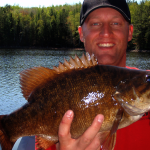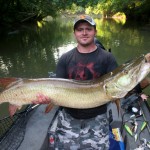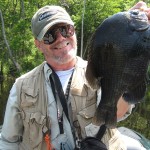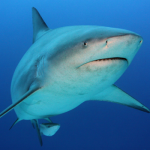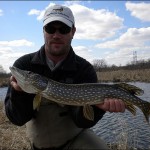David Graham – Date Posted: September 14, 2011
It can’t be overstated – to the enthusiastic angler, landing the biggest representative of a species is always better. Nonetheless the largest freshwater fish in North America is arguably its most mysterious fish. Virtually any average American, whether or not they fish recreationally, can easily identify bass or ‘bream’; and most realize that a fish with whiskers is probably a catfish.
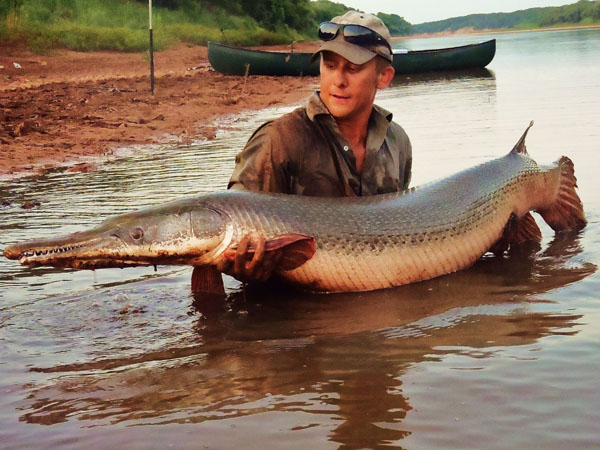
One of the most awesome, terrifying looking freshwater predators on the planet happens to thrive in a particular area of the United States, and has gone largely unnoticed by even seasoned anglers. This fish can reach more than 8 feet in length and in excess of 300 pounds, with a bill full of sharp teeth and eyes like black saucers. This amazing fish – the Alligator Gar –is North America’s largest freshwater fish, largely found in East Texas and the gulf ‘plains’ area of Louisiana. I enjoyed a fishing trip to East Texas in 2010 in search of one of these giants. Although I encountered a number of smaller, fifty pound specimens, the gargantuan trophies I had hoped for eluded me. Most frustrating, though, was the response I received from my South Carolina friends who, upon viewing my photos, declared I could not have fished these out of any American waters!
Among most American anglers, a “large fish” means a ten-pound bass, a fifty-inch musky or a big, fat catfish; the alligator gar is a fish that could leisurely snap all of these in half with one powerful slam of its toothy bill. Without question, the Alligator gar is the heavyweight champion of North American freshwater fish; on the global scale of freshwater giants, it represents team USA. The Alligator Gar has held its position as North America’s heavyweight champion since the age of the Dinosaurs. Fossil records have revealed that this fish has dominated our waterways for over 100 million years.

The Alligator Gar is the largest of the Gar family. Like the longnose, shortnose, spotted, and Florida Gar, it is easily distinguished by its toothy bill and tough ganoid scales which provide an armor like suit encasing a sturdy, muscular frame. The Alligator Gar stands distinctly apart from its smaller counterparts by its sheer size, growing more than 4 times as large as the Longnose Gar which is the second largest species of Gar. The Alligator Gar is also the only Gar species sporting two rows of teeth lining its broad bill. Larger Alligator Gar are olive green in color, transitioning to a pearl or white colored belly. They may present vague mottling; younger specimens reveal more visible spots on the rear portion of their bodies. Alligator gar also present the broadest heads of the Gars. Reports of 15 foot long, 500-pound specimens are not uncommon, but there is little legitimacy to these claims. The build and daunting appearance of this fish has cast them into a villainous light; they are frequently rumored to have attacked and perhaps killed human beings, although there is not a single documented case of this.

Even an extremely large Alligator Gar remains predominantly an opportunistic feeder. It sustains its enormous size via a very slow metabolism; it feeds primarily upon dead or dying fish, or slower moving species. The Alligator Gar, however, possesses uncanny speed and athleticism despite its size, and is fully capable of torpedoing into schools of large shad or true bass. Upon first glance, one can’t help imagining an alligator gar indiscriminately consuming anything in its path, including small children! Its appearance is deceiving, though – this gar has a very low metabolism and can go without eating for weeks on end. The Alligator Gar has falsely been accused of eating its own body weight in game fish species by ignorant anglers looking to rationalize for their own inability to capture the fish they desire.
The Alligator Gar once populated a large cross section of the South Eastern United States. They have been found as far North as West Central Illinois and as far east as South Carolina through Florida. The alligator gar is currently diminishing in number and its range has retracted almost exclusively to East Texas and Louisiana. Although it can be found in Oklahoma, Arkansas, Mississippi, and the surrounding South Central region of the United States, healthy populations of truly massive Alligator Gar are exceedingly rare and almost exclusive to East Texas, most notably the Trinity River.
There are several explanations for the dramatic decline of these magnificent gar over the past century. Habitat destruction, dams and over harvesting have all played a significant role in the decline in Alligator Gar. They are also a popular target for bow hunters, and due to their tremendous size they present a large, easy target and therefore present little ‘sport’ in terms of a shooting target. In years past, superstition, ignorance and outdated laws made it illegal to return Alligator Gar to the water. Efforts to eradicate them entirely were made to ‘protect’ people as well as more traditionally desired species of fish. It takes over 10 years for Alligator Gar to reach sexual maturity. This makes them particularly vulnerable to environmental changes and the intentional culling by sport fishermen, commercial fisherman, and bow hunters alike.
Today, the Alligator Gar seems to be re-emerging in number and size. Many states have adopted a 1 fish per day limit, and restocking programs have been successful in areas where these fish were thought to have been extinct. Alligator Gar have also become increasingly popular with North American fisherman as well as overseas anglers.
This past June I had the great fortune to return to East Texas for another opportunity to capture a truly magnificent Alligator Gar. One of the greatest challenges of catching a large specimen is supplying yourself with bait sufficiently large to entice them. On day 1 of the trip I visited a small Oklahoma pond I frequented as a child, and where I knew we could stock up on numerous common carp. Carp fishing has always been a favorite hobby of mine; I consider them to be a very formidable freshwater species by hook and line. It was an eerie feeling, knowing that three and four pound carp were being harvested as bait for something much larger. We spent a few hours capturing common carp with bread crust, keeping just enough to use as bait, and entertaining ourselves with a few catch, photo, release candidates. Once we had sufficient carp for several days on the Trinity River, we headed South.
Our first destination was the Livingston Dam, just below Texas’s Lake Livingston. It was there that my brother Travis and I had spotted some of the largest Alligator Gar, in great numbers, during our 2010 trip. The general area of the dam offered outstanding fishing for other species including white, striped and yellow bass; freshwater drum, channel catfish, common carp, smallmouth buffalo, and longnose gar. This year however, the catch was quite different. We observed several small alligator gar rolling at the surface, but it seemed there were no ‘giants’ in the area. We fished for two days without a single fish before heading North on the Trinity River.
The stretch of Trinity 15 some miles north of Lake Livingston provided better, though not consistent, action. We set up at several bends for hours at a time where we saw Alligator Gar rolling in decent numbers, though no ‘monsters’ were to be found. To maximize our chances of landing them, we would fish five rods at a time. Each rod, a sturdy 8-foot boat rod with large spinning reels spooled with 150lb powerpro braid, was established along the muddy shores of the Trinity resting on electronic bite alarms. These bite alarms are triggered when the line feeds through a groove at the head of the bite alarm. With drags set loose, as soon as fish took the bait, the line would feed out triggering a high frequency alarm audible up to a 100-yard distance. Each line was rigged with a sliding float, a 5-foot 150 lb steel leader, and either double J-Hooks or a large treble hook baited with a chunk of carp.


We frequently sat and waited, hours on end, as fish surfaced tantalizingly close to our floats, never tripping our alarms. Other times, though, the bites came almost instantly. Tending to a rod with a running fish requires concentration and patience. The Trinity River waters have little to no visibility and run thick with mud. It is virtually impossible to ascertain whether the fish on your line is an 8-foot behemoth, or a runt. Generally, an Alligator Gar takes the bait and may carry it over a hundred yards downstream before swallowing it. They often settle on bends or sit in areas where the water has eddied , perhaps to swallow the bait in the relative calm there. Alligator Gar are very patient feeders, and will take their time working the bait down. Generally, once they had turn and begin moving upstream it is time to set the hook. The entire process may take more than ten minutes.
The Trinity River is almost as unique as the massive fish that reside in its murky waters; there is something almost alien about it. In spite of the dead timber, the trash, and the broken, tattered shoreline, it has a stark, peaceful beauty.
During our time on the river we encountered numerous white tail deer, birds of prey, reptiles, amphibians , cattle, and even a large group of wild pigs crossing the river. The sunsets along the river were particularly vivid in color and beauty. It almost made the lack of fish well worth the wait.
In three days on the Trinity River we caught several smaller alligator gar ranging from 15 to approximately 40 pounds. I had a gut-wrenching feeling that I might have to leave Texas without having caught a large alligator gar. During the 4 total days we spent at different stretches of the Trinity, we could almost have thought that truly massive alligator gar no longer existed. We finally took two days off the river to rest and celebrate July 4th with friends before returning to the water.
With only one day left before my return flight to South Carolina, my brother and I decided to explore a stretch of the Red River which a local angler had tipped us off about. The Red River, which splits Oklahoma and Texas, has a healthy population of Alligator Gar although the Trinity River is better known for the beasts. Nevertheless we decided to try out the Red River; the stretch we chose required extensive twists and turns down dirt roads and unmarked paths which lead to a dirt lot beside a largely dried up stretch of river. The area we were in felt far from civilization yet somehow “just right” for the prey we sought. The river was so dried up that using a boat was nearly impossible. We dragged a canoe full of fishing gear nearly 100 yards across dried sandy riverbed to a deeper channel and began to head down stream.
For the first few hundred yards of our paddle, the river seemed void of any life form. Like the Trinity River, the water was murky and nearly stagnant. However, the Red River did not appear to have any baitfish, vegetation, timber, or anything that would sustain any sort of base for a living ecosystem. Pessimistic after four days of working hard for scarce bites, we paddled on. As we approached the bend in the river we intended to work, we were instantly rewarded with large signs of life! Packed into a very concentrated area of river along a deep hole adjacent to a rocky wall, countless gigantic alligator gar began to roll around our canoe. I knew this would be the place we would capture our giant.
The stretch of river was so remote, so secluded, and so jam packed with massive Alligator Gar, I would venture to say it is one of the last remaining such areas in existence. We set up along the muddy banks as quickly as we could. It was difficult to gather our senses and concentrate on setting up the bite alarms and organizing our gear while massive fish well over 100 pounds were surfacing everywhere around us. I was enthralled by the sight of 7 foot long fish in a freshwater river in North America. It was a surreal thing to encounter – after all, this was not the Amazon, Africa or Thailand – this was a North American, freshwater river system teeming with unimaginable numbers of fish as big as me!
Almost immediately after getting all of our baits in the water and getting set up, I received a phone call from the man who told me about the location. He had stopped up river from us and had a big fish on the line. Excited to finally at least see a large alligator gar with my own eyes, I sprinted up river along the shore to his location. We estimated the fish to be in the 80 pound range, and though to him it was a small one, it was the most amazing thing I had ever seen!
Eager to capture a giant of my own, I sprinted back to where my baits were set up. Motivated by how quickly and easily a large gar had already been brought it, I was re-energized with optimism. As the hours passed however, my frustration increased. Giant fish continued to roll as the sun began to drop. We passed the time catching numerous longnose gar on small strips of carp hide. Although we had one brief run on the bite alarms and were catching longnose gar on our medium weight rods, the big bites just were not coming.
Struck by the thought that my trip was nearly over and I had yet to land ‘the big one’, I looked at my brother and colorfully voiced my frustrations and doubts. No sooner had the words left my mouth, one of the alarms started screaming! This fish wasn’t playing; this was not an investigative nibble, it grabbed the bait with the clear intention of keeping it. Seconds passed by but felt like minutes as I knew I must wait to engage the fish that I was certain would be the fish of my lifetime. After the fish made its pass down stream and completed the turn back against the current I engaged the fish with a sturdy hookset. Upon my thrust against the pressure of the fish the rod scarcely moved past parallel as though to be pulling against an immovable object. Almost immediately after tying into the fish, I witnessed a nearly 7 foot long sea serpent of a gar propel its self out of the water in a violent tail walk.

The fight was on! The incredible fish went airborne repeatedly in an effort to evade capture. I kept on my toes from start to finish, expecting disaster of some sort to strike during the 20 minute battle. The fish was brought to shore several times only to have it retreat to the safety of the deeper channel. Eventually the massive fish succumbed to exhaustion and my brother was able to literally wrestle it to shore. It ultimately measured in at 81 inches and an estimated 140 pounds.

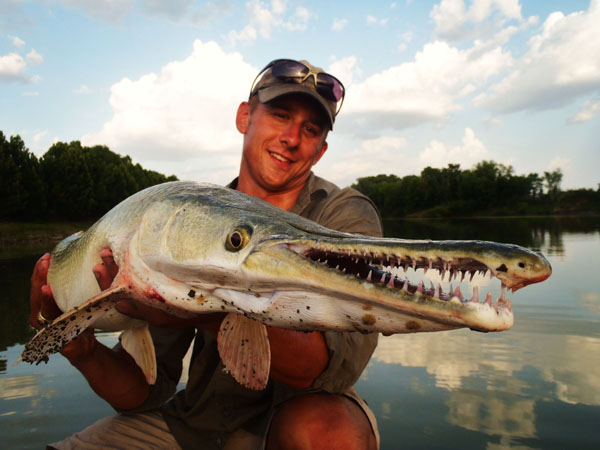
I am certain that the alligator gar is the pinnacle of freshwater fishing in the United States outside of perhaps the white sturgeon, and after having achieved a dream of mine more than 10 years in the making I can’t help but look towards future endeavors on other waters. The alligator gar is, without doubt, the quintessential freshwater predator. In my humble opinion this is the single most impressive finned creature in North American waters. The experiences I have had as an angler have helped make me the person I am today, but the experience of seeing, touching, and feeling a truly massive alligator gar has been far beyond anything else I have encountered during my years as an angler.




